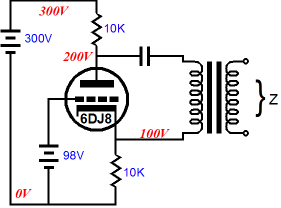Is there a name for this circuit and can anyone provide an example of it in a piece of gear? I’m not saying it’s novel but I did just come up with it unprompted. The unity gain push-pull output is its greatest asset - great back end for a mic pre of course. Good input headroom, output headroom only limited by B+, but assuming 200V it could probably do 30dBu at the trafo primary. Is its drive capability limited to its quiescent current, or does it behave like an SRPP or WCF to some degree?

EDIT: I may have screwed up the percentages of B+…might need to be 33%/33%/33% and 270V, which puts the upper follower and its resistors into 90V proper, with the lower cathode at 90 and the lower anode at 180. 200V would be a squeeze. Either way the upper and lower resistor values won’t be matching, so they shoulda gotten labeled RkA1/2 and RkB1/2. And thus it can not exceed its quiescent current at the output. But hey, still unity!
EDIT 2: From post #3, rule of thumb for starters is:
LOWER Vk .375 * B+
LOWER Va .625 * B+
UPPER Vk .750 * B+
UPPER Va 1.00 * B+
…and pick your Vgk (Rgk) first, as it will always be the same.

EDIT: I may have screwed up the percentages of B+…
EDIT 2: From post #3, rule of thumb for starters is:
LOWER Vk .375 * B+
LOWER Va .625 * B+
UPPER Vk .750 * B+
UPPER Va 1.00 * B+
…and pick your Vgk (Rgk) first, as it will always be the same.
Last edited:







